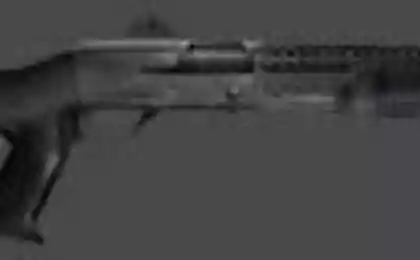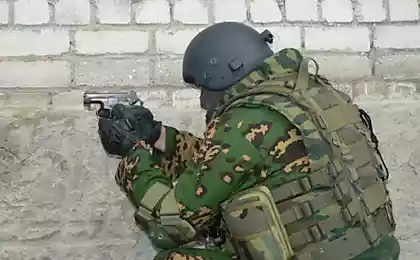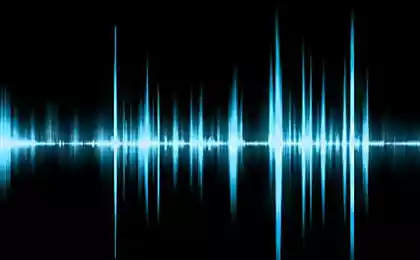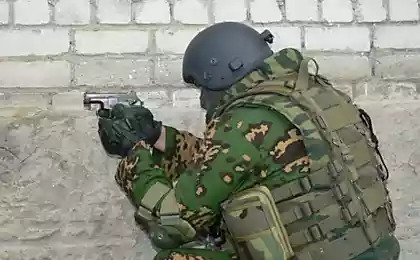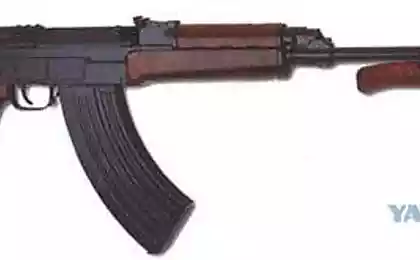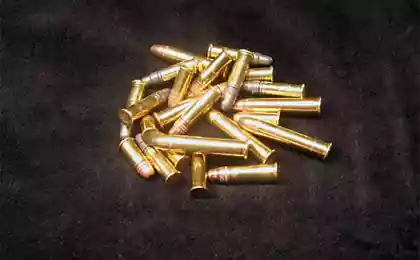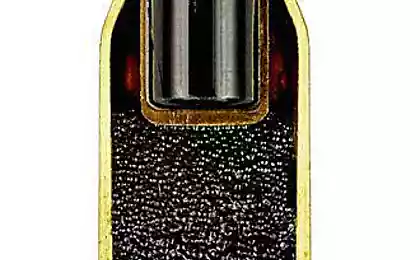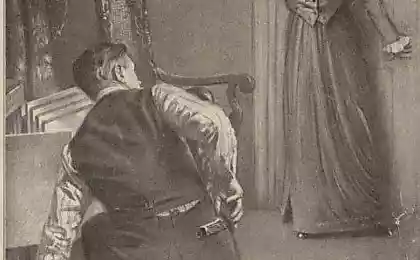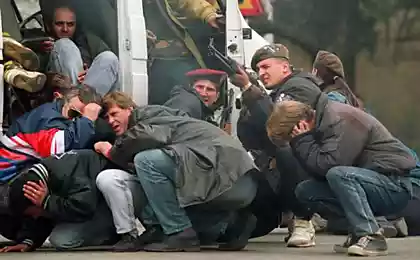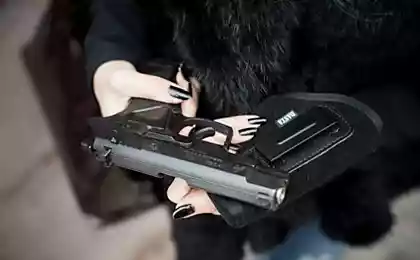1862
Echo of war - I
MP-38/40 (the full name of it. Maschinenpistole 38/40) - submachine gun, designed by Henry Follmer, used in the armed forces of Germany during World War II.
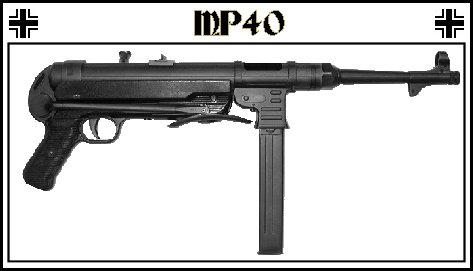
The chief designer Heinrich Follmer company Erma Werke in Erfurt using basic design Schmeisser MP 36 and develops from it the famous German submachine gun World War II, MP 38 and MP 40. It has been released 1, 2 mln. Pieces. This weapon is distributed worldwide as «Schmeisser-MP».
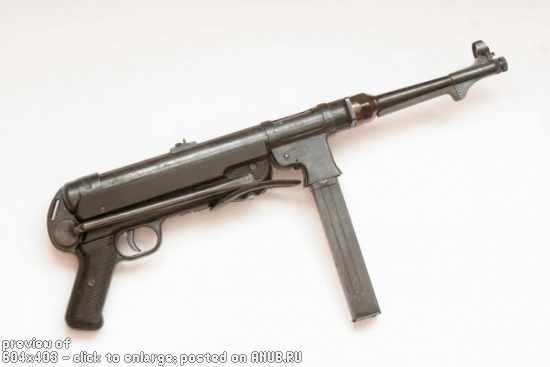
The chief designer Heinrich Follmer company Erma Werke in Erfurt using basic design Schmeisser MP 36 and develops from it the famous German submachine gun World War II, MP 38 and MP 40. It has been released 1, 2 mln. Pieces. This weapon is distributed worldwide as «Schmeisser-MP».
Submachine gun MP-40 is often traditionally called the "Schmeisser", although the designer Schmeisser to its creation had no direct relationship. This is probably due to the fact that before the MP-40 in service with the German army were submachine gun design Schmeisser (director of the firm Henel Vaffenfabrik, manufactures and MP-40), the name of which has been transferred to the new model, a model was simply named for director of the firm.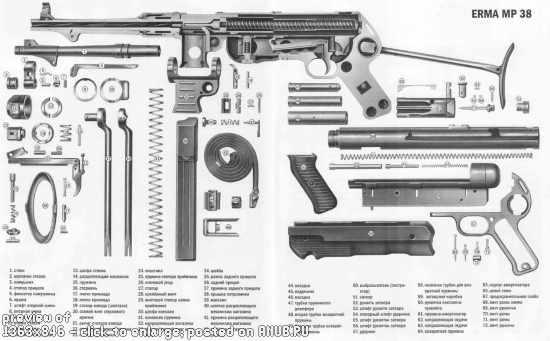
The performance characteristics of MP 40:
Caliber: 9 mm;
Chuck: 9x19 Parabellum;
the initial velocity of 380 m / s;
length with closed / unfolded butt: 630/833 mm;
rate of fire of 400 rds / min;
weight without ammunition / ammo: 4, 3.4, 7 kg;
Capacity: 32;
barrel length: 248 mm;
Effective range: 200 m.
Since coming to power in Germany, the Nazi Party was a question of equipping the growing arms of the German army. The head of the company Erfurter Maschinen Erma Berthold Geipel 1936 led the work on the creation of new weapons, with the starting sample was taken submachine gun E.MR. In anticipation of the scale of production, with a new weapon the German gunsmiths have adopted a completely new at the time the method of cold stamping parts of steel sheet. It has been applied to create a unique 9-mm submachine gun, called Erma 36. However, it later turned out that the stamped parts malonadёzhny appeared, and in this regard, when Geipel received an order from the Office of the Wehrmacht on the creation of a new submachine gun for tanks and paratroopers, he had to return to the main machined parts.
After some alteration of a new model of the company Erma was named MP-38. To reduce the cost of production in the manufacture of the forearm was used plastic (Bakelite), and the pistol grip frame was made of aluminum. One of the features of the new version was also fairly low rate of fire and the smooth operation of automation, which increased the accuracy and control of weapons (in between shots the shooter time to return weapons to the line of sight), but it was a disadvantage in the conduct of the war on Soviet territory. Severe frosts have a significant test for the MP-38. The low rate of fire and small gaps between the friction parts lead to thickening weapons lubrication at temperatures below freezing - there was a need to use a special winter grease resistant to frost.
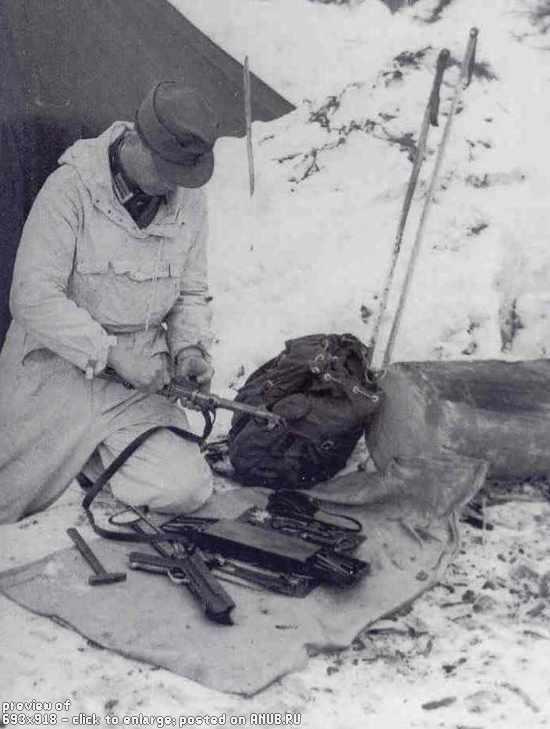
By the beginning of World War II in service of the German army was already 8772 MP-38. At the same time the first fighting there was an urgent need to improve the manufacture of the MR-38 for a mass production. In mid-1939, produced only 500 units per month in September and October - 1300, November - 1400, and in December - 1,700.
Over time, each company was to receive from 14 to 16 units of the MR-38 as a weapons platoon commanders, departments, divisions and mouth in addition to the automatic gun. Thus, the advantages have been confirmed by the new weapon.
With the onset of 1940, when the General Staff of the army was ordered to develop a new weapon, the MP-40 in large numbers began to get the arrows horsemen, drivers, tank units and staff officers. Requirements troops were now more satisfied, although not polnostyu.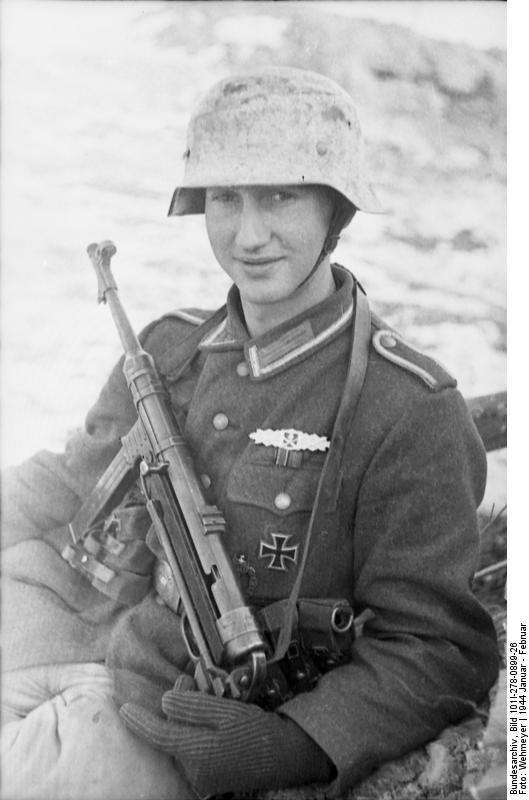
Contrary to popular belief, imposed by the feature film, where the German soldiers "poured" from the MP-40 continuous fire "from the hip", was conducted aiming fire in short bursts of 3-4 shots with emphasis buttstock shoulder. Saturation infantry submachine gun was low, MR-40 armed mostly squad leaders; more common among the crews they got tanks and armored vehicles, as well as the personnel of the Airborne Troops (about a quarter of the personnel). At the same time the beginning of the Great Patriotic War was made only a quarter of a million units of the MR-40.
With most of the paratroopers was still equipped with carbines Mauser 98 and 33/40. Later, they began to receive automatic rifle FG-42, but the mass production of the weapons did not have time to adjust.
From January 1940 to December 1941 the armed forces of a total of 464,144 units delivered submachine gun, including:
Army - 371606
Aviation - 76237
Navy - 16266.
By the end of the war a total of nearly a million machines produced
Automation as the MP-38 and MP-40 operates on the basis of the free return of the shutter. The barrel is locked massive, large gate, supported by back and mainspring. Due to the relatively large weight of moving parts and a pneumatic damper submachine gun at a relatively low rate of fire that is good affects the accuracy. MR-40 has a hammer mechanism striker type. Simple in design the trigger is designed to maintain continuous fire only, but due to the low rate of fire, well-trained shooters can shoot and single shots. Fuse from submachine gun is missing. It replaces the cut-outs for the bolt handle on the left side in the groove of the slide box. MR-40 is equipped with two rackmount sight Vizier: constant at a distance of 100 m and a convertible at a distance up to 200 m. In the conduct of fire at a distance of 200 m effective fire was rapidly deteriorating. In addition, because of the low initial velocity bullets when shooting at a distance of more than 200 m had to exceed the point of aiming at a target at 0, 5 meters, making it difficult to defeat the purpose. In combat nuisance created as lack of trunk guard, so to avoid burns while shooting soldiers often wear gloves.
Breech box is made from sheet metal. Top is a base of sight, which is a bracket for aiming the bar, where there is a permanent slot at the sight of 100 meters. On axis reinforced in the bar, made flip bracket slotted for shooting at a distance of 200 meters. The front part of the slide box wearing made of a sheet material clip. The lower part of the cage forms a receiver store and latch are inside the store and the reflector. On the right side of the receiver store on the gate lead-out box is a window to reflect the sleeves.
The shutter cylindrical shape, at present it handle loading and ejector with a spring, two cylindrical guide surface and an inner stepped bore cocked. Inside the gate is a stepped hole with the striker firing pin, connected with the details of back-and-shock system. The cylindrical rod slot and firing pin is fastened a pin striker. The outer tube of the return mechanism threaded rod itself.
The butt submachine gun MP-40 includes a number of parts. The base is taken butt pistol grip, the body of which is made with the trigger guard on her cheeks located bakelite. In the upper ledge of the housing on the lock latch axis in mobile condition attached shoulder rest with rotating butt pad. Shoulder emphasis develops a receiver, has two positions: reclined or folded. Butt fixed bayonet, which is used to transfer the shoulder all the way from one situation to another. The stock is connected with the trigger box with special screws.
Basic details
Submachine gun MP-40 consists of the following parts and tools:
Barrel with the slide box
Shutter box with handle fire control and folding shoulder rest
Shutter
The back-action spring
Trigger
Removable magazin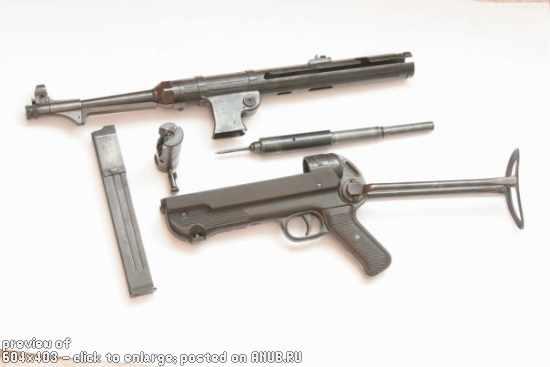
MR-41
MP-41 is a version of the MP-40 with a wooden butt, the author of this idea was Hugo Schmeisser, he set the barrel and breech box submachine gun MP-40 into a wooden box.
Also in the MR-41 an interpreter modes of fire, due to what was now easier to maintain a single fire. The new submachine gun was increased to the normal rate of fire. Thanks to the wooden butt now had the opportunity to shoot more accurately, but significant advantages of MR-41 compared to already become popular and famous submachine gun MP-40 was not. This was the reason that the MP-41 was produced in small quantities.

Comparative characteristics of various models of MP-36 MP-38 MP-41
Cartridge 9 × 19mm Parabellum
Initial speed m / s 380
Length with folded / unfolded butt, mm: 620/831 630/833 864
Rate of fire, Venue / min: 350-400 400 500
Weight unloaded / ammunition, kg: 3, 96/4, 63 4, 18/4, 85 3, 87/4, 54
Capacity of shop: 32 cartridges
Barrel length, mm: 248 251
Sighting range, m: 200
Initially, MP-40 was designed as a weapon for assault units and tankers, in connection with which there has been applied a folding butt. In the MR-40 proved to be rather successful design, and in connection with this sub-machine gun was put into mass production, they began to arm and conventional infantry units. The disadvantage of metal stock and not quite successful connection system (hinge butt with frequent tilting fast break in and began to stagger, which affected the accuracy of shooting) led to the creation of the model MP-41, in which the same mechanism was placed in a wooden box, but for economic reasons mass production of the new model has not started.
The advantages of MP-40 is compact, easy operation and high reliability with proper care, a relatively low rate of fire and good handling weapons.
Disadvantages are primarily related to the selected cartridge. The ballistic characteristics of the cartridge 9 × 19mm Parabellum could not give a large muzzle velocity and thus a good flat trajectory. As a result, when shooting at 200 meters had to take a sight about half a meter above the point of impact. From the soldiers were reports that the maximum distance (200 m or more) in some cases, a bullet could not have hit that goal, so they do not have adequate stopping power. However, the low range of fire - this is a general lack of weapons under the pistol cartridge. From the actual design flaws can be detected:
Already mentioned the failed joint butt construction;
The absence of the barrel jacket (which is why when firing a weapon was impossible to keep the barrel without gloves)
Because of the long, heavily favored down the removable cartridge magazine has been difficult to fire from cover (especially the trench) as for accurate shooting had to poke his head heavily than commonly used snipers;
Disadvantages are primarily related to the selected cartridge. The ballistic characteristics of the cartridge 9 × 19mm Parabellum could not give a large muzzle velocity and thus a good flat trajectory. As a result, when shooting at 200 meters had to take a sight about half a meter above the point of impact. From the soldiers were reports that the maximum distance (200 m or more) in some cases, a bullet could not have hit that goal, so they do not have adequate stopping power. However, the low range of fire - this is a general lack of weapons under the pistol cartridge. From the actual design flaws can be detected:
Already mentioned the failed joint butt construction;
The absence of the barrel jacket (which is why when firing a weapon was impossible to keep the barrel without gloves)
Because of the long, heavily favored down the removable cartridge magazine has been difficult to fire from cover (especially the trench) as for accurate shooting had to poke his head heavily than commonly used snipers; 87,802,162
On Reliability MP-40 a little inferior to the Soviet PPSh-41 and PPP. In addition, when fighting in the Soviet Union showed a reduction of reliability in sub-zero temperatures.
MP-40 was used extensively in World War II troops of the Third Reich. Used in Poland, France, Italy, Africa, Holland, the Soviet Union, and others. As captured weapons used by the soldiers of the Ukrainian Insurgent Army, which, like the Soviet soldiers who mined it in battles with German troops.
It is valued in the Red Army for the accuracy and reliability.
On the eve of World War II, the German army was in need of a compact weapon, but has a good firepower - more than a conventional gun. In this role came submachine gun MP-38, which was used together with older MP-18, MP-28, MP-35 and MP-34 Austrian.
Experience the Wehrmacht pushed for a more active and widespread use of submachine guns and, accordingly, demanded modernization. Submachine gun MP-38 first armed assault troops, tank crews and the military police. Later they began to supply all kinds of troops. MP-38 became the first staff in the submachine gun of German armed forces after MR 18.I. However, the first time, the MP-38 was not enough, and they could not oust Mauser rifle. The situation began to change only after adopting a new modification of LL-40 - now began to arm these weapons and advanced part of the Wehrmacht, but the lack of a firm butt was a certain lack of weapons, which led to the creation of the MR-41. MP-40 during the war, was actively used by partisans in all countries, mainly because of difficulties in the supply of a minimum of ammunition. MP-38 and MP-40 is actively used by scouts, saboteurs and special detachment, as the MP-40 was much lighter than the Soviet PPSh-41 or the PDP, as well as facilitate the actions of the groups behind enemy lines saturation ammunition 9h19Para.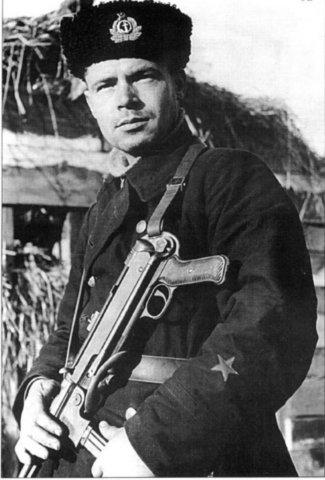
MP-40 after the war
After World War II, MP-40 restrictions apply to several armed conflicts: the submachine gun used by the British special forces SAS, it was used both opposing sides during the war for Israel's independence. Israeli paratroopers, as well as English, used it until 1960. Single copies are still found in the Vietnam and Afghanistan wars, but in Germany this weapon was forgotten for political reasons. In 1956, armed with the Army of Yugoslavia was adopted submachine gun M56, is actually a simplified modification of the MP40.
Thanks to Soviet films about the Great Patriotic War, the MP-40 as the "Schmeisser" was to personify a certain image of German "war machine." This weapon was a real symbol of the German blitzkrieg. The impression was that virtually all of the German army was armed with MP-40. In reality it was not so. MP-40 armed with practically only front-line units, and in them he was not a major firearms. At 10 million Mauser rifles accounted for only slightly more than one million submachine guns MP-40. In addition, the movie was created by a special way of "Nazi machine gunner" with a tight eye on the helmet with the "automatic", "Schmeisser" - leading the fire from the hip, holding a gun shop and going for a bullet to his full height. So simple way masters of propaganda as it attempted to justify the failure of the tactical nature of the initial period of the Great Patriotic War - the Wehrmacht with its polls with automatic weapons a hundred times superior to the Red Army, able to snap a single rifle fire. In fact, the German troops were not as "automatic". On average, in 1941 the department relied on infantry only one MR.40 (for the Commander), as part of an infantry company including 16 submachine guns and 132 carbine "Mauser» Kar.98k.

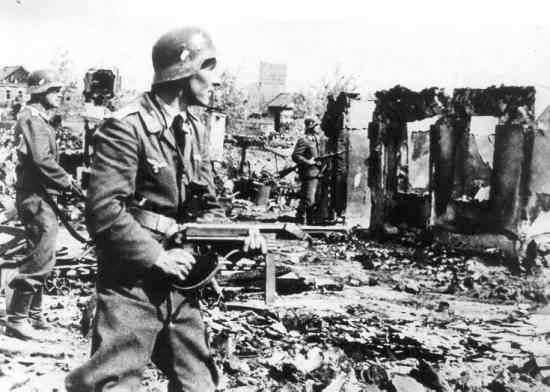
MP-40 is often vstrechaetsya in computer games. He is in all 3D shooters on the Second World War. In the series:
Medal of Honor (series)
Call of Duty (series) except 4th part
Brothers in Arms (series)
as well as games:
Death to Spies (computer game)
MP-40 was one of the first 3D shooter that has an indirect relationship to the Second World: Wolfenstein 3D
and its remake: Return to Castle Wolfenstein
Just dostatchno common tactical simulators as dedicated to the 2nd World and not directly related to it.
7.62
Behind Enemy Lines
Behind Enemy Lines 2
Fallout Tactics

The chief designer Heinrich Follmer company Erma Werke in Erfurt using basic design Schmeisser MP 36 and develops from it the famous German submachine gun World War II, MP 38 and MP 40. It has been released 1, 2 mln. Pieces. This weapon is distributed worldwide as «Schmeisser-MP».

The chief designer Heinrich Follmer company Erma Werke in Erfurt using basic design Schmeisser MP 36 and develops from it the famous German submachine gun World War II, MP 38 and MP 40. It has been released 1, 2 mln. Pieces. This weapon is distributed worldwide as «Schmeisser-MP».
Submachine gun MP-40 is often traditionally called the "Schmeisser", although the designer Schmeisser to its creation had no direct relationship. This is probably due to the fact that before the MP-40 in service with the German army were submachine gun design Schmeisser (director of the firm Henel Vaffenfabrik, manufactures and MP-40), the name of which has been transferred to the new model, a model was simply named for director of the firm.

The performance characteristics of MP 40:
Caliber: 9 mm;
Chuck: 9x19 Parabellum;
the initial velocity of 380 m / s;
length with closed / unfolded butt: 630/833 mm;
rate of fire of 400 rds / min;
weight without ammunition / ammo: 4, 3.4, 7 kg;
Capacity: 32;
barrel length: 248 mm;
Effective range: 200 m.
Since coming to power in Germany, the Nazi Party was a question of equipping the growing arms of the German army. The head of the company Erfurter Maschinen Erma Berthold Geipel 1936 led the work on the creation of new weapons, with the starting sample was taken submachine gun E.MR. In anticipation of the scale of production, with a new weapon the German gunsmiths have adopted a completely new at the time the method of cold stamping parts of steel sheet. It has been applied to create a unique 9-mm submachine gun, called Erma 36. However, it later turned out that the stamped parts malonadёzhny appeared, and in this regard, when Geipel received an order from the Office of the Wehrmacht on the creation of a new submachine gun for tanks and paratroopers, he had to return to the main machined parts.
After some alteration of a new model of the company Erma was named MP-38. To reduce the cost of production in the manufacture of the forearm was used plastic (Bakelite), and the pistol grip frame was made of aluminum. One of the features of the new version was also fairly low rate of fire and the smooth operation of automation, which increased the accuracy and control of weapons (in between shots the shooter time to return weapons to the line of sight), but it was a disadvantage in the conduct of the war on Soviet territory. Severe frosts have a significant test for the MP-38. The low rate of fire and small gaps between the friction parts lead to thickening weapons lubrication at temperatures below freezing - there was a need to use a special winter grease resistant to frost.

By the beginning of World War II in service of the German army was already 8772 MP-38. At the same time the first fighting there was an urgent need to improve the manufacture of the MR-38 for a mass production. In mid-1939, produced only 500 units per month in September and October - 1300, November - 1400, and in December - 1,700.
Over time, each company was to receive from 14 to 16 units of the MR-38 as a weapons platoon commanders, departments, divisions and mouth in addition to the automatic gun. Thus, the advantages have been confirmed by the new weapon.
With the onset of 1940, when the General Staff of the army was ordered to develop a new weapon, the MP-40 in large numbers began to get the arrows horsemen, drivers, tank units and staff officers. Requirements troops were now more satisfied, although not polnostyu.

Contrary to popular belief, imposed by the feature film, where the German soldiers "poured" from the MP-40 continuous fire "from the hip", was conducted aiming fire in short bursts of 3-4 shots with emphasis buttstock shoulder. Saturation infantry submachine gun was low, MR-40 armed mostly squad leaders; more common among the crews they got tanks and armored vehicles, as well as the personnel of the Airborne Troops (about a quarter of the personnel). At the same time the beginning of the Great Patriotic War was made only a quarter of a million units of the MR-40.
With most of the paratroopers was still equipped with carbines Mauser 98 and 33/40. Later, they began to receive automatic rifle FG-42, but the mass production of the weapons did not have time to adjust.
From January 1940 to December 1941 the armed forces of a total of 464,144 units delivered submachine gun, including:
Army - 371606
Aviation - 76237
Navy - 16266.
By the end of the war a total of nearly a million machines produced
Automation as the MP-38 and MP-40 operates on the basis of the free return of the shutter. The barrel is locked massive, large gate, supported by back and mainspring. Due to the relatively large weight of moving parts and a pneumatic damper submachine gun at a relatively low rate of fire that is good affects the accuracy. MR-40 has a hammer mechanism striker type. Simple in design the trigger is designed to maintain continuous fire only, but due to the low rate of fire, well-trained shooters can shoot and single shots. Fuse from submachine gun is missing. It replaces the cut-outs for the bolt handle on the left side in the groove of the slide box. MR-40 is equipped with two rackmount sight Vizier: constant at a distance of 100 m and a convertible at a distance up to 200 m. In the conduct of fire at a distance of 200 m effective fire was rapidly deteriorating. In addition, because of the low initial velocity bullets when shooting at a distance of more than 200 m had to exceed the point of aiming at a target at 0, 5 meters, making it difficult to defeat the purpose. In combat nuisance created as lack of trunk guard, so to avoid burns while shooting soldiers often wear gloves.
Breech box is made from sheet metal. Top is a base of sight, which is a bracket for aiming the bar, where there is a permanent slot at the sight of 100 meters. On axis reinforced in the bar, made flip bracket slotted for shooting at a distance of 200 meters. The front part of the slide box wearing made of a sheet material clip. The lower part of the cage forms a receiver store and latch are inside the store and the reflector. On the right side of the receiver store on the gate lead-out box is a window to reflect the sleeves.
The shutter cylindrical shape, at present it handle loading and ejector with a spring, two cylindrical guide surface and an inner stepped bore cocked. Inside the gate is a stepped hole with the striker firing pin, connected with the details of back-and-shock system. The cylindrical rod slot and firing pin is fastened a pin striker. The outer tube of the return mechanism threaded rod itself.
The butt submachine gun MP-40 includes a number of parts. The base is taken butt pistol grip, the body of which is made with the trigger guard on her cheeks located bakelite. In the upper ledge of the housing on the lock latch axis in mobile condition attached shoulder rest with rotating butt pad. Shoulder emphasis develops a receiver, has two positions: reclined or folded. Butt fixed bayonet, which is used to transfer the shoulder all the way from one situation to another. The stock is connected with the trigger box with special screws.
Basic details
Submachine gun MP-40 consists of the following parts and tools:
Barrel with the slide box
Shutter box with handle fire control and folding shoulder rest
Shutter
The back-action spring
Trigger
Removable magazin

MR-41
MP-41 is a version of the MP-40 with a wooden butt, the author of this idea was Hugo Schmeisser, he set the barrel and breech box submachine gun MP-40 into a wooden box.
Also in the MR-41 an interpreter modes of fire, due to what was now easier to maintain a single fire. The new submachine gun was increased to the normal rate of fire. Thanks to the wooden butt now had the opportunity to shoot more accurately, but significant advantages of MR-41 compared to already become popular and famous submachine gun MP-40 was not. This was the reason that the MP-41 was produced in small quantities.

Comparative characteristics of various models of MP-36 MP-38 MP-41
Cartridge 9 × 19mm Parabellum
Initial speed m / s 380
Length with folded / unfolded butt, mm: 620/831 630/833 864
Rate of fire, Venue / min: 350-400 400 500
Weight unloaded / ammunition, kg: 3, 96/4, 63 4, 18/4, 85 3, 87/4, 54
Capacity of shop: 32 cartridges
Barrel length, mm: 248 251
Sighting range, m: 200
Initially, MP-40 was designed as a weapon for assault units and tankers, in connection with which there has been applied a folding butt. In the MR-40 proved to be rather successful design, and in connection with this sub-machine gun was put into mass production, they began to arm and conventional infantry units. The disadvantage of metal stock and not quite successful connection system (hinge butt with frequent tilting fast break in and began to stagger, which affected the accuracy of shooting) led to the creation of the model MP-41, in which the same mechanism was placed in a wooden box, but for economic reasons mass production of the new model has not started.
The advantages of MP-40 is compact, easy operation and high reliability with proper care, a relatively low rate of fire and good handling weapons.
Disadvantages are primarily related to the selected cartridge. The ballistic characteristics of the cartridge 9 × 19mm Parabellum could not give a large muzzle velocity and thus a good flat trajectory. As a result, when shooting at 200 meters had to take a sight about half a meter above the point of impact. From the soldiers were reports that the maximum distance (200 m or more) in some cases, a bullet could not have hit that goal, so they do not have adequate stopping power. However, the low range of fire - this is a general lack of weapons under the pistol cartridge. From the actual design flaws can be detected:
Already mentioned the failed joint butt construction;
The absence of the barrel jacket (which is why when firing a weapon was impossible to keep the barrel without gloves)
Because of the long, heavily favored down the removable cartridge magazine has been difficult to fire from cover (especially the trench) as for accurate shooting had to poke his head heavily than commonly used snipers;
Disadvantages are primarily related to the selected cartridge. The ballistic characteristics of the cartridge 9 × 19mm Parabellum could not give a large muzzle velocity and thus a good flat trajectory. As a result, when shooting at 200 meters had to take a sight about half a meter above the point of impact. From the soldiers were reports that the maximum distance (200 m or more) in some cases, a bullet could not have hit that goal, so they do not have adequate stopping power. However, the low range of fire - this is a general lack of weapons under the pistol cartridge. From the actual design flaws can be detected:
Already mentioned the failed joint butt construction;
The absence of the barrel jacket (which is why when firing a weapon was impossible to keep the barrel without gloves)
Because of the long, heavily favored down the removable cartridge magazine has been difficult to fire from cover (especially the trench) as for accurate shooting had to poke his head heavily than commonly used snipers; 87,802,162
On Reliability MP-40 a little inferior to the Soviet PPSh-41 and PPP. In addition, when fighting in the Soviet Union showed a reduction of reliability in sub-zero temperatures.
MP-40 was used extensively in World War II troops of the Third Reich. Used in Poland, France, Italy, Africa, Holland, the Soviet Union, and others. As captured weapons used by the soldiers of the Ukrainian Insurgent Army, which, like the Soviet soldiers who mined it in battles with German troops.
It is valued in the Red Army for the accuracy and reliability.
On the eve of World War II, the German army was in need of a compact weapon, but has a good firepower - more than a conventional gun. In this role came submachine gun MP-38, which was used together with older MP-18, MP-28, MP-35 and MP-34 Austrian.
Experience the Wehrmacht pushed for a more active and widespread use of submachine guns and, accordingly, demanded modernization. Submachine gun MP-38 first armed assault troops, tank crews and the military police. Later they began to supply all kinds of troops. MP-38 became the first staff in the submachine gun of German armed forces after MR 18.I. However, the first time, the MP-38 was not enough, and they could not oust Mauser rifle. The situation began to change only after adopting a new modification of LL-40 - now began to arm these weapons and advanced part of the Wehrmacht, but the lack of a firm butt was a certain lack of weapons, which led to the creation of the MR-41. MP-40 during the war, was actively used by partisans in all countries, mainly because of difficulties in the supply of a minimum of ammunition. MP-38 and MP-40 is actively used by scouts, saboteurs and special detachment, as the MP-40 was much lighter than the Soviet PPSh-41 or the PDP, as well as facilitate the actions of the groups behind enemy lines saturation ammunition 9h19Para.

MP-40 after the war
After World War II, MP-40 restrictions apply to several armed conflicts: the submachine gun used by the British special forces SAS, it was used both opposing sides during the war for Israel's independence. Israeli paratroopers, as well as English, used it until 1960. Single copies are still found in the Vietnam and Afghanistan wars, but in Germany this weapon was forgotten for political reasons. In 1956, armed with the Army of Yugoslavia was adopted submachine gun M56, is actually a simplified modification of the MP40.
Thanks to Soviet films about the Great Patriotic War, the MP-40 as the "Schmeisser" was to personify a certain image of German "war machine." This weapon was a real symbol of the German blitzkrieg. The impression was that virtually all of the German army was armed with MP-40. In reality it was not so. MP-40 armed with practically only front-line units, and in them he was not a major firearms. At 10 million Mauser rifles accounted for only slightly more than one million submachine guns MP-40. In addition, the movie was created by a special way of "Nazi machine gunner" with a tight eye on the helmet with the "automatic", "Schmeisser" - leading the fire from the hip, holding a gun shop and going for a bullet to his full height. So simple way masters of propaganda as it attempted to justify the failure of the tactical nature of the initial period of the Great Patriotic War - the Wehrmacht with its polls with automatic weapons a hundred times superior to the Red Army, able to snap a single rifle fire. In fact, the German troops were not as "automatic". On average, in 1941 the department relied on infantry only one MR.40 (for the Commander), as part of an infantry company including 16 submachine guns and 132 carbine "Mauser» Kar.98k.


MP-40 is often vstrechaetsya in computer games. He is in all 3D shooters on the Second World War. In the series:
Medal of Honor (series)
Call of Duty (series) except 4th part
Brothers in Arms (series)
as well as games:
Death to Spies (computer game)
MP-40 was one of the first 3D shooter that has an indirect relationship to the Second World: Wolfenstein 3D
and its remake: Return to Castle Wolfenstein
Just dostatchno common tactical simulators as dedicated to the 2nd World and not directly related to it.
7.62
Behind Enemy Lines
Behind Enemy Lines 2
Fallout Tactics
